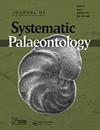The most complete extinct species of Testudo (Testudines, Testudinidae) defined by several well-preserved skeletons from the late Miocene of Romania
IF 2.2
2区 地球科学
Q3 EVOLUTIONARY BIOLOGY
引用次数: 8
Abstract
The genus Testudo was considered, for more than two centuries, to group almost all tortoises that are part of current biodiversity (i.e. the members of Testudinidae), as well as the extinct representatives of that successful lineage. However, only three extant species, as well as scarce late Miocene to late Pliocene extinct ones, are now considered attributable to that genus. The fossil record of the extinct representatives is restricted to postcranial elements. They correspond almost exclusively to shells or partial shells, most of the species being known on the basis of only one individual. Abundant material of testudinids from the late Miocene of eastern Romania (Crețești 1 fossil site, Vaslui County) is presented here. This material is attributable to Testudo, representing a new species. This find is not only relevant for the abundance of specimens, but they stand out for their unusually good preservation. Most of them are represented by partial skeletons, preserving not only several bones in anatomical connection but also some regions of the peculiar ossified dermal armour that covered their limbs. Two of these skeletons preserve the skull, which allows us to perform both the first three-dimensional reconstruction of the cranial anatomy and the first neuroanatomical study of an extinct member of Testudo. The best-preserved extinct species of the reference genus of the only extant lineage of tortoises (i.e. Testudinidae), Testudo lohanica sp. nov., is characterized in detail.由罗马尼亚中新世晚期保存完好的几具骨架确定的最完整的已灭绝的狐猴物种(狐猴目,狐猴科)
两个多世纪以来,龟属被认为囊括了几乎所有属于当前生物多样性的龟类(即龟科的成员),以及这一成功谱系中已灭绝的代表。然而,只有三个现存的物种,以及稀少的中新世晚期到上新世晚期灭绝的物种,现在被认为属于该属。已灭绝的代表动物的化石记录仅限于颅骨后的元素。它们几乎完全与壳或部分壳相对应,大多数物种仅以一个个体为基础。本文介绍了罗马尼亚东部晚中新世(Crețești 1化石遗址,Vaslui县)大量的龙尾类材料。这一材料属于泰斯图多,它代表了一个新物种。这一发现不仅与丰富的标本有关,而且因其异常完好的保存而引人注目。它们中的大多数以部分骨骼为代表,不仅保留了解剖连接的几块骨骼,而且还保留了覆盖四肢的特殊骨化真皮甲的一些区域。其中两具骨架保留了头骨,这使我们能够进行第一次颅骨解剖的三维重建和第一次对已灭绝的特斯图多成员的神经解剖学研究。本文详细描述了现存唯一陆龟谱系(即陆龟科)参考属中保存最完好的灭绝种——陆龟(Testudo lohanica sp. nov.)。
本文章由计算机程序翻译,如有差异,请以英文原文为准。
求助全文
约1分钟内获得全文
求助全文
来源期刊
CiteScore
5.30
自引率
7.70%
发文量
31
审稿时长
>12 weeks
期刊介绍:
The Journal of Systematic Palaeontology publishes papers that provide novel and impactful results in phylogenetics and systematics and that use these results in ways that significantly advance rigorous analyses of palaeogeography, palaeobiology, functional morphology, palaeoecology or biostratigraphy. Papers dealing with theoretical issues or molecular phylogenetics are also considered if they are of relevance to palaeo-systematists. Contributions that include substantial anatomical descriptions, descriptions of new taxa or taxonomic revisions are welcome, but must also include a substantial systematics component, such as a new phylogeny or a revised higher-level classification. Papers dealing primarily with alpha-taxonomic descriptions, the presentation of new faunal/floristic records or minor revisions to species- or genus-level classifications do not fall within the remit of the journal.

 求助内容:
求助内容: 应助结果提醒方式:
应助结果提醒方式:


